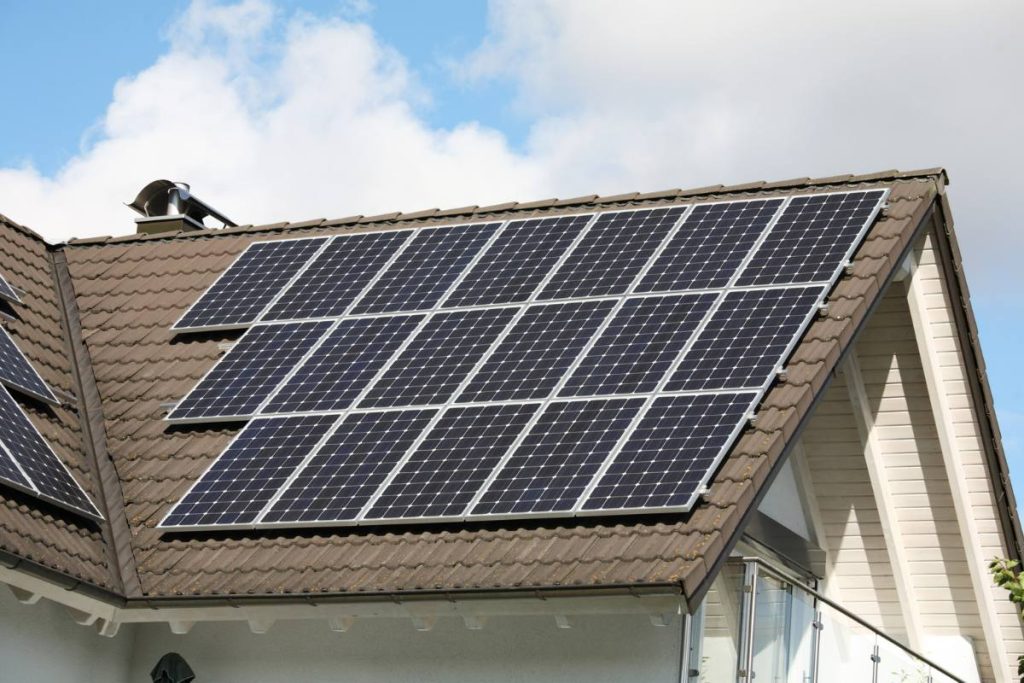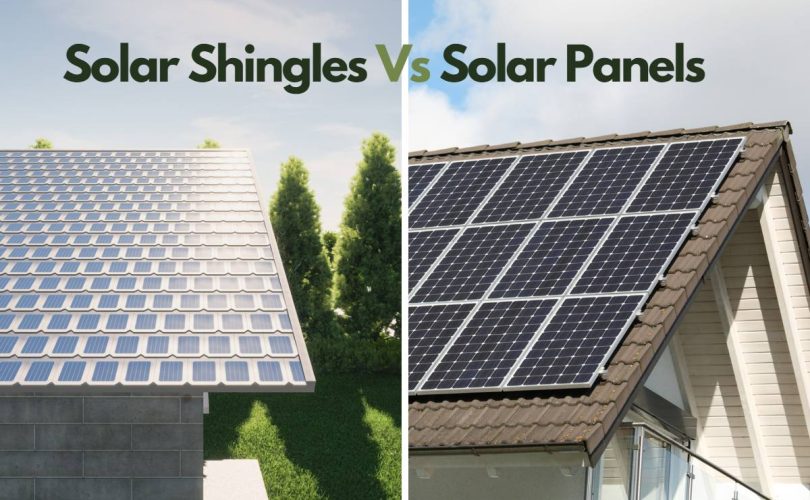Solar roof shingles and solar panels have some similarities and differences between them. For similarities, we’re talking about their technology, eco-friendliness, cost-effectiveness, suitability for net metering, etc. On the flip side, their differences include appearance, flexibility, cost, etc. In the solar shingles vs solar panels debate, this solar energy blog compares and contrasts the qualities and abilities of both solar power products designed to provide the same function – electricity for a building.
Solar Panels

Solar panels are surfaces or plates embedded with a series of solar cells and semiconductors. When linked or connected to each other and positioned properly for optimal exposure to the sun, these panels generate a sufficient amount of electricity for the building it’s installed on. You can install solar panels atop a roof or on ground mounts if the roof size is insufficient for the number of solar panels you need to install. They work with or without batteries depending on the kind of solar system you want in place.
Solar panels come in varieties – amorphous silicon panels, thin-film panels, polycrystalline panels, and monocrystalline panels.
Solar Shingles

Solar shingles are miniature semblances of roofing materials such as asphalt shingles. They’re smaller than regular solar panels and they work the same way by capturing solar power from the sunthe sun to produce electricity for the building. You can install them on the roof and they mostly form the existing roof of the building itself – which makes them capable of serving two functions simultaneously. Solar shingles also come in varieties – copper indium gallium selenide solar shingles and silicon solar shingles.
Similarities
In the solar shingles vs solar panels debate we know, that both are products of renewable energy, i.e., solar power, it’s expected that solar shingles and traditional solar panels will share some similarities between them.
How They Work
Both are manufactured with integrated solar cells or photovoltaics, making them capable of absorbing solar energy and converting it into usable electricity for the building. As solar power products, solar tiles and standard solar panels require good exposure to function optimally. As we mentioned earlier, they both function with and without batteries depending on the setup of the solar energy system. They also work with inverters which convert DC electricity to AC electricity.
Environmentally-friendly
Since they don’t require fossil fuels to generate electricity, their power production has been significant in reducing carbon emissions into the environment. Instead, what they require is direct exposure to sunlight. For this reason, many homeowners are installing solar shingles or solar panels on their properties.
Cost-effectiveness
Solar panels and shingles cost a lot to install on your properties, but in the long run, you’ll realize that you’ve saved a lot of money. Both the solar shingle and solar panel are very durable. Considering the number of years they can generate electricity, their purchase and cost for installation are nothing compared to what you’ll spend on fossil fuels or conventional electricity within that period.
Solar panel installation or solar roofing comes with a significant reduction or even elimination of energy bills. Imagine not paying electricity bills for roughly 20 years. Do you know how much that is? It’s a lot.
Easy to Maintain
One of the best things about a solar roof installation or solar panels is that they don’t need much maintenance to function optimally. This is one of the reasons they’re cost-effective in the long run because the cost of purchasing and installing shingles and panels are virtually the only expenses you may have to make.
For the solar panels, you just need to clean their surfaces once or twice a year to remove any dust coating or debris that will impair their function.
Suitability for Net Metering
Whether it’s solar shingle installation or traditional panels installation you want to go for, you can earn from both. If there’s a net metering policy in your area of residence, that means you can export excess electricity back to the grid and earn utility credits.
Durability
What we consider arguably the best thing is their impressive durability. With lifespans ranging between 25 and 30 years, both solar products are capable of providing you with residential solar power for a long time.
Solar Incentives
It doesn’t matter whether you want to install solar panels or carry out solar shingle installations on your property to produce renewable energy, both systems make you eligible for certain solar rebates or benefits. A good example is the federal solar tax credit. This will offset the total cost of the system, a favorable prospect especially if you’re using the products of pricey brands such as Tesla Solar Roof.
Differences
Affordability
The cost of installing solar shingles compared to that of solar panels has a vast difference. The installation of solar roofs is hardly the project for a budget-conscious homeowner. This is because solar shingles are very expensive to install. Unlike solar panels, solar shingles are not popular and just a few solar installers sell them.
The cost of solar shingles depends on the manufacturer you’re buying from. Tesla solar shingles are the most expensive solar shingles on the market and installing them means you’ll spend far more than you’ll spend on using from other brands. Another factor that influences the cost of solar tiles per square foot lies in how many solar shingles you want to install. The more solar shingles you need to install, the higher the cost, and vice versa. The cost of installing shingles can be up to $64k.
Solar panels, on the other hand, are more affordable to install and they take less time. Like shingles, solar panels cost depends on the amount of electricity consumed by the home, the type of panel used, and the brand of solar panels used. A solar panel system can cost as much as $3ok.
Energy Efficiency
Solar panels are more energy-efficient. We consider this an anti-climax because installing shingles is far more expensive than installing panels. The latter is mounted on the roof in a way that there’s some gap between it and the existing roof. This enables the dissipation of heat.
There’s no space between the shingle and the roof because the shingle is the roof replacement. The lack of space makes it impossible for heat to dissipate.
Furthermore, solar panels are more flexible and their positioning on the roof can be changed to ensure top sun exposure. Solar tiles are like your new roof, so removing them is like removing your roof. In summary, they’re more rigid and not prone to re-positioning for more sun exposure.
Lastly, a panel has more wattage than a solar shingle. The panel wattage ranges between 170W and 450W while the shingle ranges from 13W to 70W. This means you’ll need much more high-efficiency solar shingles installed than you’ll need panels for the same amount of wattage.
Appearance
Solar shingles, as we mentioned earlier, look like conventional roofing materials. Most solar shingles can easily pass for existing roof shingles. Because of their appearance, solar shingles blend seamlessly with your current roofing material when installed. This is why they can easily serve as a total roof replacement if you need a new roof.
Solar shingles are also smaller than solar panels and they have more visual appeal than them. Solar panels are bulkier and they occupy more space on your roof as a result. 10 panels can take up the space of 50-100 solar shingles.
Purpose
Solar panels make up a solar system that simply provides electricity for you by utilizing solar energy. On the other hand, shingles do more than that, they can also serve as part of your roof or your entire roof. They are ideal if you have to repair or replace your roof before installing a solar system.







